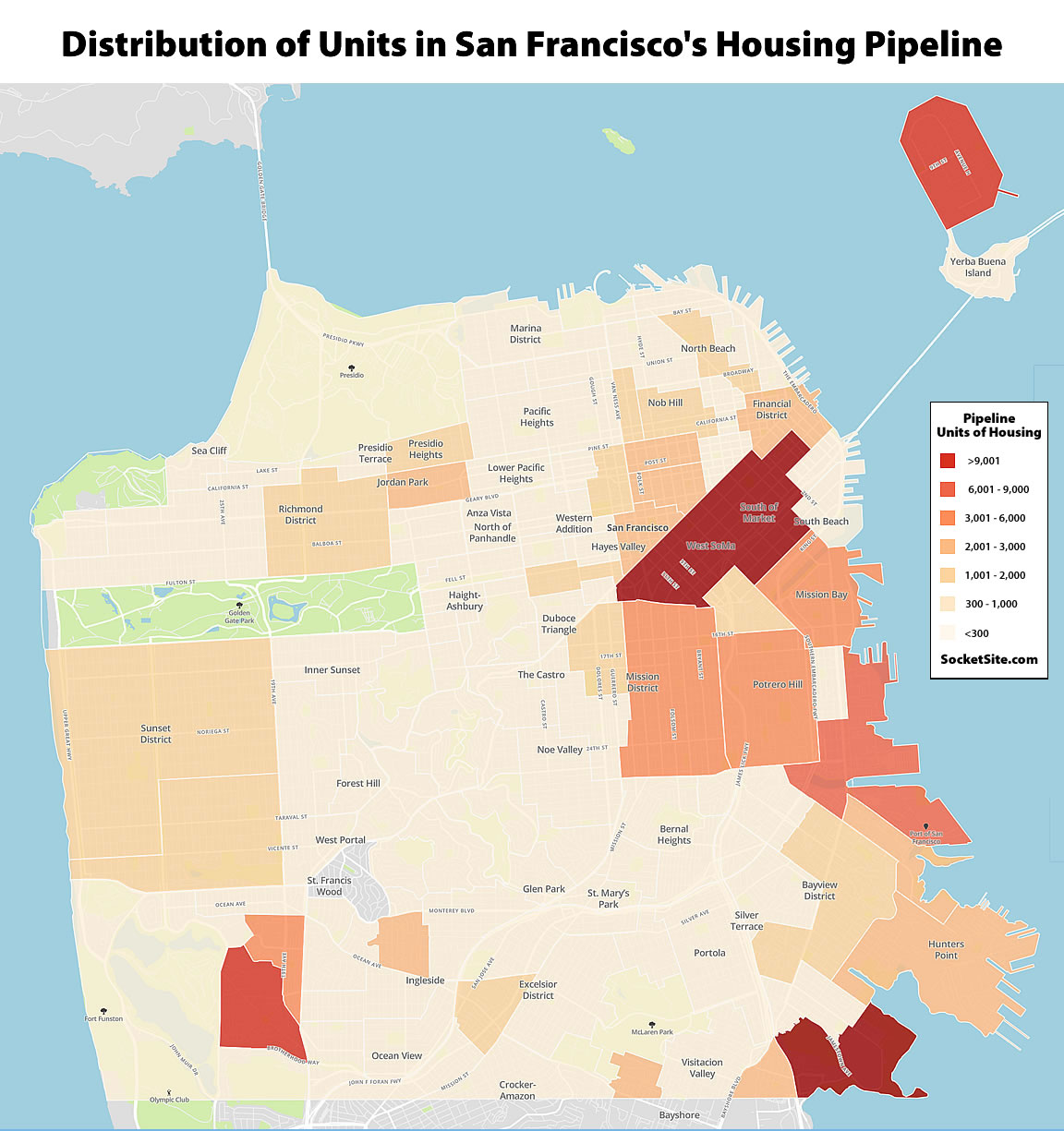With values dropping, the cost of capital having jumped, sales down, and developers getting squeezed or even foreclosed upon, the number of net new units of housing under construction across San Francisco has dropped to around 5,000, representing the fewest units of housing under construction in the city in nearly a decade.
That being said, there are still over 70,000 units of housing in various stages of development across San Francisco, which is 10 percent more than average over the past decade and effectively even with the same time last year, including fully approved and permitted plans for 5,000 units of housing which have yet to break ground; another 12,000 units of housing which have been approved by Planning and applications to secure building permits have been filed; and over 33,000 units of housing which have already been approved by Planning but for which the permitting process has yet to be initiated.
In addition, plans for another 14,000 units have been drafted and proposed, representing over 60 percent more newly proposed units than there were at the same time last year, over 10 percent more newly proposed units than average over the past decade, and over twice as many newly proposed units in the pipeline than there were in early 2012.

How many decades is the Park Merced area going to be “in pipeline?”
This is the reason why “pipeline” shouldn’t even be a factor in the housing element. In fact if a site was in the inventory for a past element it should not be permitted to count toward RHNA in the current element.
Let’s have a look at what’s holding things up. Chiefly, funding, no? It is therefore the State that should be ponying up substantially in support of the realization of the State’s own mandate.
There is plenty of funding available, but private sector developers have decided that they can’t make their desired profit margins at the prevailing interest rates the funding is available for, so they overwhelmingly aren’t taking advantage of available funding to actually build.
As far as public sector development, In case you’re new to California, former Gov. Jerry Brown dissolved redevelopment agencies statewide in the early 2010’s, killing a vital source of affordable housing funding for California cities. He followed that up by vetoing a 2015 bill that would have expanded the state’s tax credit for affordable housing.
This year (California’s fiscal year begins in July), the California legislature managed to cobble together a $310 billion state budget that barely managed to cover a $30 billion-plus deficit without dipping into key reserves. That deficit is due to the drawdown in the stock market in 2022 and it’s impact on California’s income tax receipts, especially from high earners that are leaving the state in droves. For this year, State budget analysts recently projected a record $68-billion deficit because of a 25% drop in personal income tax collection in 2023.
“$30 billion-plus deficit”. I am rather pointing to the flip side of the medallion – the State dialing the full court press back towards a more reasonable stance – in proportion to their monetary contributions to the solution. Are there signs this is happening? Perhaps, considering how the BoS last hour maneuvers on the housing element went through a couple weeks back.
Where can one find the database that this map is based on? Concept of ‘pipeline to fruition’ is nice, but after pandemic, higher interest rates and inflation, and WFH, it is hard to see how any project budgeted out before 2022 is still viable. Seems SF must fix SOMA, if already built apartments there stop losing value, then potential for more units to be built. I know, geo diversity, but the SOMA units could still be built a lot faster than units like this one at Sac/Webster. Or, everyone could stop pretending about the 82,000 units. What a farce.
What percentage of those units are subsidized? In the Mission they can’t give the stuff away. It’s mostly non-residents now. They’re placing foreign nationals. It’s nuts.
They’re not being given away, they’re being rented at affordable rates to the low-income families whose breadwinners clean your yard, take care of your children, and wash the dishes at your favorite trattoria. Where do you want those people to live?
Btw, the four recent affordable projects on and just off 16th from Mission to Folsom look much nicer and neighborhood-agreeable than any of the dystopic condo-loft crapola built for tech yuppies over the last almost three decades.
“It’s mostly non-residents now”
This is, technically speaking, a nonsense statement: I believe they meant non-citizens; which I suppose hints at an answer your question (where do you want them to live?)…”where they came from”
If you grant ‘unlivablecity’ the benefit of the doubt, you could interpret “non-residents” as describing the set of people who did not move from another San Francisco address when they were allocated a unit in The Mission.
Well then they’d be formernon-residents, wouldn’t they?. But why give that benefit: the sentence that follows provides the context, I believe.